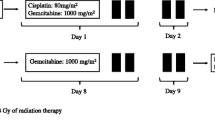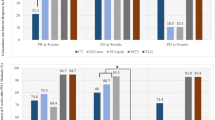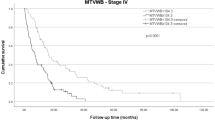Abstract
Background
We evaluated 18F-FDG PET/CT in small cell lung cancer (SCLC) staging and assessed metabolic (SUVmax, MTV and TLG) and morphologic (CTvol) variables as predictors for overall survival (OS) and progression-free survival (PFS).
Methods
Patients with newly diagnosed, histopathology-confirmed SCLC, who underwent 18F-FDG PET/CT were evaluated. A Cox proportional hazard model was used to determine the association between the primary tumour SUVmax, MTV, TLG and CTvol with OS and PFS. Similar evaluations were performed when hilar/mediastinal lymphadenopathy was included [total SUVmax (TSUVmax), total MTV (TMTV) and total TLG (TTLG)].
Results
55 patients were included. 18F-FDG PET/CT changed staging in 6/55 (10.9%) patients who were upstaged to extensive disease. TTLG (>443.8) was a significant variable for OS with HR=2.1 (CI 1.14–3.871, p=0.017). Patients with TTLG>443.8 had a median OS of 13.4 months compared to 25.7 months in patients with TTLG<443.8 (p=0.018). TMTV (>72.4) was significant for PFS with HR=2.3 (CI 1.11-4.8, p=0.025). A median PFS of 12.1 and 26.2 months was found with TMTV greater and less than 72.4, respectively (p=0.005).
Conclusions
18F-FDG PET/CT improved staging of patients with SCLC, and TTLG and TMTV can be used as prognostic variables for OS and PFS, respectively.
Key Points
• Identifying variables that predict the prognosis of patients with SCLC is important.
• 18F-FDG PET/CT influences staging of patients with SCLC.
• Metabolic parameters could be used as predictors for PFS and OS.




Similar content being viewed by others
Abbreviations
- CTvol:
-
Computed tomography volume
- MTV:
-
Metabolic tumour volume
- NSCLC:
-
Non-small cell lung cancer
- SCLC:
-
Small cell lung cancer
- SUVmax:
-
Maximum standardized uptake value
- TLG:
-
Total lesion glycolisis
References
Karve SJ, Price GL, Davis KL, Pohl GM, Smyth E, Bowman L (2014) Comparison of demographics, treatment patterns, health care utilization, and costs among elderly patients with extensive-stage small cell and metastatic non-small cell lung cancers. BMC Health Serv Res 14(1):555
Van Meerbeeck JP, Fennell DA, De Ruysscher DKM (2011) Small-cell lung cancer. Lancet 378(9804):1741–1755
Brink I, Schumacher T, Mix M et al (2004) Impact of [18F] FDG-PET on the primary staging of small-cell lung cancer. Eur J Nuc Med Mol Imaging 31(12):1614–1620
Diniz G, Unlu I, Gokce T et al (2006) Evaluation of curative and palliative radiotherapy efficacy in extensive stage small cell lung cancer. Saudi Med J 27(7):992–996
Gallamini A, Zwarthoed C, Borra A (2014) Positron Emission Tomography (PET) in Oncology. Cancers 6(4):1821–1889
Al-Sarraf N, Gately K, Lucey J et al (2008) Clinical implication and prognostic significance of standardised uptake value of primary non-small cell lung cancer on positron emission tomography: analysis of 176 cases. Eur J Cardio Thorac Surg Off J Eur Assoc Cardio Thorac Surg 34(4):892–897
Zhang H, Wroblewski K, Appelbaum D, Pu Y (2013) Independent prognostic value of whole-body metabolic tumor burden from FDG-PET in non-small cell lung cancer. Int J Comput Assist Radiol Surg 8(2):181–191
Lee YJ, Cho A, Cho BC et al (2009) High tumor metabolic activity as measured by fluorodeoxyglucose positron emission tomography is associated with poor prognosis in limited and extensive stage small-cell lung cancer. Clin Cancer Res Off J Am Assoc Cancer Res 15(7):2426–2432
Watson WL, Berg JW (1962) Oat cell lung cancer. Cancer 15:759–768
Thomson D, Hulse P, Lorigan P, Faivre-Finn C (2011) The role of positron emission tomography in management of small cell lung cancer. Lung Cancer Amst Neth 73(2):121–126
Ruben JD, Ball DL (2012) The efficacy of PET staging for small-cell lung cancer: a systematic review and cost analysis in the Australian setting. J Thorac Oncol Off Publ Int Assoc Study Lung Cancer 7(6):1015–1020
Fischer BM, Mortensen J, Langer SW et al (2007) A prospective study of PET/CT in initial staging of small-cell lung cancer: comparison with CT, bone scintigraphy and bone marrow analysis. Ann Oncol Off J Eur Soc Med Oncol ESMO 18(2):338–345
Foster NR, Mandrekar SJ, Schild SE et al (2009) Prognostic factors differ by tumor stage for small cell lung cancer: a pooled analysis of North Central Cancer Treatment Group trials. Cancer 115(12):2721–2731
Pandit N, Gonen M, Krug L, Larson SM (2003) Prognostic value of [18F]FDG-PET imaging in small cell lung cancer. Eur J Nucl Med Mol Imaging 30(1):78–84
Arslan N, Tuncel M, Kuzhan O et al (2011) Evaluation of outcome prediction and disease extension by quantitative 2-deoxy-2-[18F] fluoro-D-glucose with positron emission tomography in patients with small cell lung cancer. Ann Nucl Med 25(6):406–413
Acknowledgments
The scientific guarantor of this publication is Dr Hanna Bernstine. The authors of this manuscript declare no relationships with any companies whose products or services may be related to the subject matter of the article. The authors state that this work has not received any funding. One of the authors has significant statistical expertise. Institutional review board approval was obtained. Written informed consent was waived by the institutional review board. Methodology: retrospective, observational, performed at one institution.
Author information
Authors and Affiliations
Corresponding author
Additional information
Liran Domachevsky and Alona Zer contributed equally to this work.
Rights and permissions
About this article
Cite this article
Zer, A., Domachevsky, L., Rapson, Y. et al. The Role of 18F-FDG PET/CT on Staging and Prognosis in Patients with Small Cell Lung Cancer. Eur Radiol 26, 3155–3161 (2016). https://doi.org/10.1007/s00330-015-4132-2
Received:
Revised:
Accepted:
Published:
Issue Date:
DOI: https://doi.org/10.1007/s00330-015-4132-2




